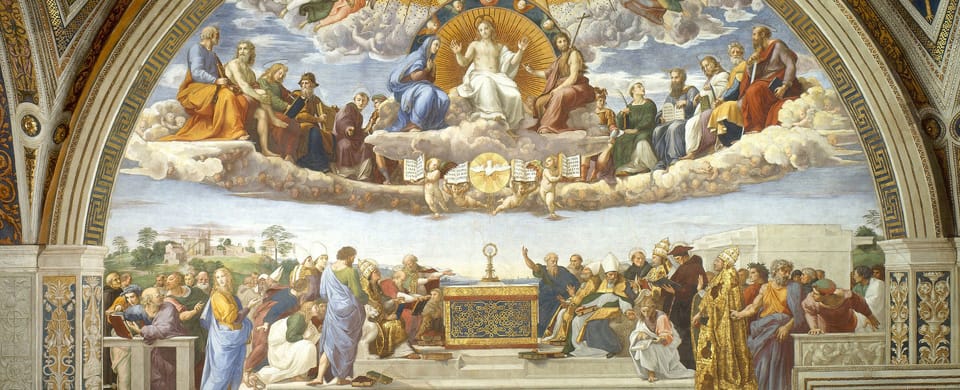The Room of the Segnatura was the place where the Holy See’s highest court met and it was the first work the young Raphael did as soon as he arrived in the Vatican.
When the artist began this first effort, Michelangelo had just started to paint the Sistine Chapel only a few meters away. So the year 1508 marks the beginning of two immense masterpieces.
The frescoes in the Room of the Segnatura were designed to show the principal categories of the Human Spirit, according to Plato: “Goodness”, “Truth” and “Beauty”.
Raphael portrayed the theme of Truth with two frescoes: the "Dispute over the Holy Sacrament" that symbolizes theological Truth and the "School of Athens" which represents the Truth of the philosophers.
A curious fact of this room is the presence of graffiti. These were left by the Landsknechts during the notorious Sack of Rome in 1527; one graffiti praises Luther.
School of Athens
Right in front of the Theological Truth you can see the Truth of rational thought and philosophy represented by the School of Athens.
Disputation of the Holy Sacrament
The Dispute of the Holy Sacrament has particular importance: it was in fact Raphael’s very first work in the Vatican. In a semicircular space we find the image of the Trinity, surrounded by saints and prophets, all sitting on a long bench made of clouds.
Below, costumed as Theologists, some very famous faces of the time can be recognized: Dante, Fra Angelico and the monk Savonarola who had been hanged and burned at the stake for heresy only ten years before.
Parnassus
The idea of “Beauty” in the third fresco is represented by a view of "Parnassus", the mythological home of Apollo and the Muses, right above the window that looks out over the Courtyard of the Belvedere, a clear allusion to beauty and perfection but it also looks out onto the Vatican Hill, visible from the window.
Raphael wanted to pay homage to it because, according to legend, a temple dedicated to Apollo was situated on top of the hill in ancient times.
The god is seated in the center and plays the lyre while surrounded by the nine muses, protectors of the arts as well as of ancient and modern poets. You can recognize Homer, Virgil, Dante at his shoulder and, seated lower and to the left, Sappho, the famous Greek poetess.
Cardinal and Theological Virtues
On the opposite wall from the "Parnassus" are the "Virtues"; underneath are two scenes centered around the emperor Justinian (the work is by Lorenzo Lotto) and, to the right, Pope Gregory IX, painted in the likeness of Julius II.






